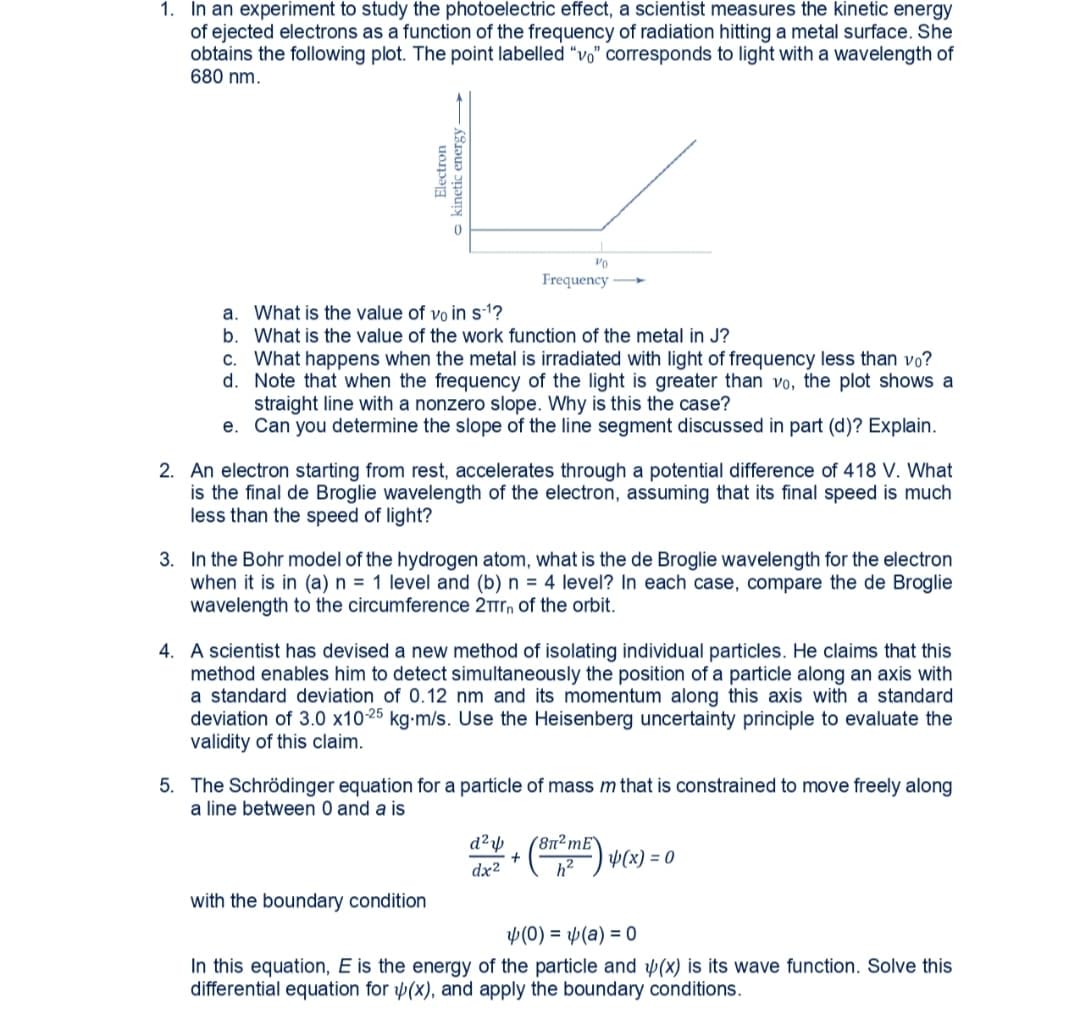4. A scientist has devised a new method of isolating individual particles. He claims that this method enables him to detect simultaneously the position of a particle along an axis with a standard deviation of 0.12 nm and its momentum along this axis with a standard deviation of 3.0 x1025 kg-m/s. Use the Heisenberg uncertainty principle to evaluate the validity of this claim.
4. A scientist has devised a new method of isolating individual particles. He claims that this method enables him to detect simultaneously the position of a particle along an axis with a standard deviation of 0.12 nm and its momentum along this axis with a standard deviation of 3.0 x1025 kg-m/s. Use the Heisenberg uncertainty principle to evaluate the validity of this claim.
Chemistry: Principles and Reactions
8th Edition
ISBN:9781305079373
Author:William L. Masterton, Cecile N. Hurley
Publisher:William L. Masterton, Cecile N. Hurley
Chapter6: Electronic Structure And The Periodic Table
Section: Chapter Questions
Problem 80QAP: In the photoelectric effect, electrons are ejected from a metal surface when light strikes it. A...
Related questions
Concept explainers
Atomic Structure
The basic structure of an atom is defined as the component-level of atomic structure of an atom. Precisely speaking an atom consists of three major subatomic particles which are protons, neutrons, and electrons. Many theories have been stated for explaining the structure of an atom.
Shape of the D Orbital
Shapes of orbitals are an approximate representation of boundaries in space for finding electrons occupied in that respective orbital. D orbitals are known to have a clover leaf shape or dumbbell inside where electrons can be found.
Question
Pls answer number 4 thank youu

Transcribed Image Text:1. In an experiment to study the photoelectric effect, a scientist measures the kinetic energy
of ejected electrons as a function of the frequency of radiation hitting a metal surface. She
obtains the following plot. The point labelled "vo" corresponds to light with a wavelength of
680 nm.
Frequency
a. What is the value of vo in s-1?
b. What is the value of the work function of the metal in J?
c. What happens when the metal is irradiated with light of frequency less than vo?
d. Note that when the frequency of the light is greater than vo, the plot shows a
straight line with a nonzero slope. Why is this the case?
e. Can you determine the slope of the line segment discussed in part (d)? Explain.
2. An electron starting from rest, accelerates through a potential difference of 418 V. What
is the final de Broglie wavelength of the electron, assuming that its final speed is much
less than the speed of light?
3. In the Bohr model of the hydrogen atom, what is the de Broglie wavelength for the electron
when it is in (a) n = 1 level and (b) n = 4 level? In each case, compare the de Broglie
wavelength to the circumference 2Tr, of the orbit.
4. A scientist has devised a new method of isolating individual particles. He claims that this
method enables him to detect simultaneously the position of a particle along an axis with
a standard deviation of 0.12 nm and its momentum along this axis with a standard
deviation of 3.0 x1025 kg-m/s. Use the Heisenberg uncertainty principle to evaluate the
validity of this claim.
5. The Schrödinger equation for a particle of mass m that is constrained to move freely along
a line between 0 and a is
(8n²mE`
W(x) = 0
dx2
with the boundary condition
y(0) = p(a) = 0
In this equation, E is the energy of the particle and (x) is its wave function. Solve this
differential equation for (x), and apply the boundary conditions.
Electron
o kinetic energy
Expert Solution
This question has been solved!
Explore an expertly crafted, step-by-step solution for a thorough understanding of key concepts.
This is a popular solution!
Trending now
This is a popular solution!
Step by step
Solved in 2 steps with 2 images

Knowledge Booster
Learn more about
Need a deep-dive on the concept behind this application? Look no further. Learn more about this topic, chemistry and related others by exploring similar questions and additional content below.Recommended textbooks for you

Chemistry: Principles and Reactions
Chemistry
ISBN:
9781305079373
Author:
William L. Masterton, Cecile N. Hurley
Publisher:
Cengage Learning

Principles of Modern Chemistry
Chemistry
ISBN:
9781305079113
Author:
David W. Oxtoby, H. Pat Gillis, Laurie J. Butler
Publisher:
Cengage Learning

Physical Chemistry
Chemistry
ISBN:
9781133958437
Author:
Ball, David W. (david Warren), BAER, Tomas
Publisher:
Wadsworth Cengage Learning,

Chemistry: Principles and Reactions
Chemistry
ISBN:
9781305079373
Author:
William L. Masterton, Cecile N. Hurley
Publisher:
Cengage Learning

Principles of Modern Chemistry
Chemistry
ISBN:
9781305079113
Author:
David W. Oxtoby, H. Pat Gillis, Laurie J. Butler
Publisher:
Cengage Learning

Physical Chemistry
Chemistry
ISBN:
9781133958437
Author:
Ball, David W. (david Warren), BAER, Tomas
Publisher:
Wadsworth Cengage Learning,

Chemistry: An Atoms First Approach
Chemistry
ISBN:
9781305079243
Author:
Steven S. Zumdahl, Susan A. Zumdahl
Publisher:
Cengage Learning


Chemistry
Chemistry
ISBN:
9781305957404
Author:
Steven S. Zumdahl, Susan A. Zumdahl, Donald J. DeCoste
Publisher:
Cengage Learning